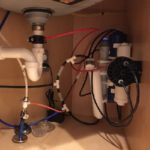Recently we went on a road trip. Road trips are a big deal this summer as aging boomers exaggerate stories of past vacations while loose in large station wagons as kids. Air fare was so expensive the only way we afforded to carry a large family a long distance was by car. Seat beats optional. Family trips are focused on getting everyone to the airport these days, back then we were focused on the daylong/nightlong car ride to get there. (Check out this book on the subject, “Don’t Make Me Pull Over!” by Richard Ratay).

Anyway, we figured out how far we could fly, rent a car, then drive back to Wilmington in a week. We landed on Denver. We plotted a course through Kansas, Arkansas, Tennessee, Mississippi, Georgia and South Carolina to get back home. We spent our first two days in Colorado. Denver, we thought, would be the trip highlight, and we had a good time. Once in the car we watched the countryside roll by in slow motion. Like Lon Chaney changing into the Wolfman, the view outside morphed from high plains to hilly scrubs to Mississippi delta right before our eyes. Try that at 30,000 feet. Our plan was to rest up in Memphis before striking out for home.
We imagined Memphis as a waypoint. But Memphis turned out to be the highlight of our trip. We toured to Graceland. (Check out the two-volume biography of Elvis by Peter Guralnick, “Last Train to Memphis” and “Careless Love” then put Graceland on your bucket list). We went to the civil rights museum at the Lorraine Motel, where Martin Luther King was assassinated. We stayed in the Peabody Hotel and watched the ducks walk into the elevator. But most importantly, we felt like we were home.

Memphis is like old Wilmington. Sure, the Mississippi is bigger than the Cape Fear river and Memphis is bigger than Wilmington like Savannah, but it’s not as brassy as Charleston, and not as commercial as New Orleans. I was immediately at home. Downtown Memphis is mostly old buildings with a lot of old signs from the 50’s and 60’s. Cold Cathode tubes spell out brand names to light up the night. Summertime humidity settled around my shoulders like a favorite bathrobe. I hummed old Bob Dylan lyrics, “Stuck inside of Mobile with the Memphis blues again”. I pretended I was JFK. But instead of, “Ich bin ein Berliner”, I said, “Nací en Memphis”.
We had a great time, but the next time we may forgo the road and fly into Memphis to spend the week.




 One consequence of our desire to build where nature and man will most certainly battle, is its effect on sea life dependent on the beach for basic animal reproduction. Unfortunately, nesting Sea Turtles fall directly into the path of our desire to enjoy the beach fronts where we build. Thankfully, our coastal region has stepped up to solve and control this man vs. nature moment with local organizations such as the Pleasure Island Sea Turtle Project.
One consequence of our desire to build where nature and man will most certainly battle, is its effect on sea life dependent on the beach for basic animal reproduction. Unfortunately, nesting Sea Turtles fall directly into the path of our desire to enjoy the beach fronts where we build. Thankfully, our coastal region has stepped up to solve and control this man vs. nature moment with local organizations such as the Pleasure Island Sea Turtle Project.

 One day I spent some time with a child, named David, who knew my job was in architecture. He told me about how he liked to draw and asked me to draw a house with him. We ended up drawing a floor plan of a house together. I asked him the typical things like what do you want it to look like or have in it? He drew as we talked making a theater room to one side, an art room for his big sister, guest rooms with multiple bunk beds (I’m talking like 6 bunk beds in one room), and a long hallway where they could line up all their shoes. His ideas were fun and imaginative, although he nearly forgot to add a bathroom to the house! Once he felt he was finished, he then moved on to another activity and person in our group.
One day I spent some time with a child, named David, who knew my job was in architecture. He told me about how he liked to draw and asked me to draw a house with him. We ended up drawing a floor plan of a house together. I asked him the typical things like what do you want it to look like or have in it? He drew as we talked making a theater room to one side, an art room for his big sister, guest rooms with multiple bunk beds (I’m talking like 6 bunk beds in one room), and a long hallway where they could line up all their shoes. His ideas were fun and imaginative, although he nearly forgot to add a bathroom to the house! Once he felt he was finished, he then moved on to another activity and person in our group. Just a while ago, we were working with hand drawn scheme proposals for a client. This indeed was a pleasant change of pace at the office. It took me around three days to complete this task and prepare it for submittal. Unfortunately, engaging in this pleasantry became challenging way too soon for me. Anyone who has begun a diet on a Monday, and thought about giving up on that same afternoon, can relate to this.
Just a while ago, we were working with hand drawn scheme proposals for a client. This indeed was a pleasant change of pace at the office. It took me around three days to complete this task and prepare it for submittal. Unfortunately, engaging in this pleasantry became challenging way too soon for me. Anyone who has begun a diet on a Monday, and thought about giving up on that same afternoon, can relate to this. When my family and I prepared to move here four years ago, we were already concerned with the quality of the water. The Cape Fear River travels a long way before getting to the watershed where we were going to be planting our family and who knew what the river might pick up along its way? We asked around the UNCW biology department, where my husband had been accepted as an assistant professor, before arriving to see if anyone else held the same concerns, but heard nothing alarming until last June when the news about GenX emerged.
When my family and I prepared to move here four years ago, we were already concerned with the quality of the water. The Cape Fear River travels a long way before getting to the watershed where we were going to be planting our family and who knew what the river might pick up along its way? We asked around the UNCW biology department, where my husband had been accepted as an assistant professor, before arriving to see if anyone else held the same concerns, but heard nothing alarming until last June when the news about GenX emerged. The crack researcher, my husband, got online and chose the
The crack researcher, my husband, got online and chose the 







